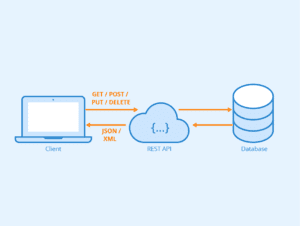Table of Contents
Welcome back to WordPress Whispers! As many of you know, WordPress is a leading content management system that powers about 43% of websites on the internet (2023). One of its powerful features, the WordPress REST API, can significantly enhance the functionality of e-commerce sites. Its versatility and robust set of features make it a preferred choice for developers and business owners. One such feature, the WordPress REST API, is a powerful tool that can significantly enhance ecommerce sites by providing a way to interact with the site’s data remotely.
The WordPress REST API (Representational State Transfer Application Programming Interface) creates endpoints for WordPress data types, allowing developers to fetch, create, update, or delete data from anywhere. This capability is crucial for e-commerce sites, which require dynamic and interactive elements to provide a seamless user experience.
E-commerce sites often have complex structures and need a flexible system to manage data effectively. The WordPress REST API meets this need by enabling e-commerce site owners to link their main website with various devices, integrate with external services, and enhance site functionality.
Today, we’ll explore how to use the WordPress REST API for e-commerce sites. We’ll cover setup, enhancing e-commerce functionality, and ensuring security. Whether you’re a WordPress developer or an e-commerce business owner, this guide will provide valuable insights into leveraging the WordPress REST API.
Finally, as technology continues to evolve, it’s important to stay updated with the latest versions of software and follow current best practices when implementing new features on your site.
Resources:
- WordPress REST API Handbook – WordPress Developer Resources
- WordPress REST API Tutorial: A Beginner’s Guide
- How to Use The WordPress REST API Plugin
- How Is eCommerce Rest API Revolutionary for Your Online Store?
- Turn Your WordPress Site into a Powerful E-Commerce Store With WooCommerce
- WordPress REST API | What is it and How to Secure WP REST APIs

Understanding the WordPress REST API
The WordPress REST API is a feature that allows developers to interact with a WordPress site remotely. But what exactly is a REST API, and how does it work with WordPress?
REST stands for Representational State Transfer. It is an architectural style used in web development to create an application or web service. An API, or Application Programming Interface, is a set of rules that allows different software applications to communicate with each other.
In the context of WordPress, the REST API provides a way for developers to retrieve or send data to their WordPress site using JSON, a lightweight data-interchange format. This means that you can interact with your WordPress site using HTTP methods like GET, POST, PUT, and DELETE.
Here’s a simple example of how you might use the WordPress REST API to retrieve a list of posts:
fetch('https://yourwebsite.com/wp-json/wp/v2/posts')
.then(response => response.json())
.then(posts => console.log(posts));
In this example, we’re using the fetch function to send a GET request to the /wp-json/wp/v2/posts endpoint of our WordPress site. The server responds with a JSON object containing a list of posts, which we then log to the console.
The WordPress REST API is particularly important for e-commerce sites. E-commerce sites often need to interact with a variety of services, such as payment gateways, shipping providers, and customer relationship management systems. The WordPress REST API makes it possible to integrate these services directly into your WordPress site, creating a more seamless user experience and making it easier to manage your e-commerce operations.
Resources:
- WordPress REST API Handbook – WordPress Developer Resources
- Using the WordPress REST API – WP Engine
- REST API – WooCommerce Developer Documentation
Setting Up the WordPress REST API for E-Commerce
Setting up the WordPress REST API for your e-commerce site involves a few key steps. Let’s walk through the process:
1. Enable the WordPress REST API
The WordPress REST API is included and enabled by default in WordPress 4.7 and later. If you’re using an older version of WordPress, you may need to update your WordPress installation or use a plugin to enable the REST API.
2. Install and Configure WooCommerce
WooCommerce is a popular e-commerce plugin for WordPress that includes its own set of REST API endpoints. Install and activate the WooCommerce plugin from your WordPress dashboard, then follow the setup wizard to configure your store.
3. Generate API Keys
To use the WooCommerce REST API, you’ll need to generate API keys. These keys are used to authenticate your application’s requests. From your WordPress dashboard, navigate to WooCommerce > Settings > Advanced > REST API. Click “Add key” to generate a new set of keys.
4. Configure Your Application
In your application, you’ll need to configure it to use your API keys and the WooCommerce REST API endpoints. The exact process will depend on your application, but generally, you’ll need to include your API keys in the headers of your HTTP requests.
Here’s an example of how you might use the WooCommerce REST API to retrieve a list of products:
fetch('https://yourwebsite.com/wp-json/wc/v3/products', {
headers: {
'Authorization': 'Basic ' + btoa('consumer_key:consumer_secret')
}
})
.then(response => response.json())
.then(products => console.log(products));
In this example, we’re using the fetch function to send a GET request to the /wp-json/wc/v3/products endpoint of our WordPress site. We include our API keys in the ‘Authorization’ header of our request. The server responds with a JSON object containing a list of products, which we then log to the console.
Managing your API keys is crucial for the security of your e-commerce site. Treat your API keys like passwords and keep them secure. Do not share your keys publicly, and consider using environment variables or secure storage solutions to store your keys.
Resources:

Using the WordPress REST API with WooCommerce
WooCommerce is a powerful, open-source e-commerce solution built specifically for WordPress. It allows you to transform your WordPress website into a fully functional e-commerce store, and it’s used by millions of small and large businesses around the world.
One of the key features of WooCommerce is its integration with the WordPress REST API. This integration allows developers to interact with the WooCommerce data (like products, orders, customers, and more) programmatically, which opens up a wide range of possibilities for custom development and integration with other services.
To use the WooCommerce REST API, you first need to generate API keys, as mentioned in the previous section. Once you have your keys, you can use them to authenticate your requests to the WooCommerce endpoints.
Here’s an example of how you might use the WooCommerce REST API to create a new product:
const productData = {
name: 'New Product',
type: 'simple',
regular_price: '9.99',
description: 'This is a new product.',
categories: [
{
id: 9
},
{
id: 14
}
],
images: [
{
src: 'http://demo.woothemes.com/woocommerce/wp-content/uploads/sites/56/2013/06/T_2_front.jpg'
},
{
src: 'http://demo.woothemes.com/woocommerce/wp-content/uploads/sites/56/2013/06/T_2_back.jpg'
}
]
};
fetch('https://yourwebsite.com/wp-json/wc/v3/products', {
method: 'POST',
headers: {
'Content-Type': 'application/json',
'Authorization': 'Basic ' + btoa('consumer_key:consumer_secret')
},
body: JSON.stringify(productData)
})
.then(response => response.json())
.then(product => console.log(product));
In this example, we’re sending a POST request to the /wp-json/wc/v3/products endpoint of your WordPress site to create a new product. We include our API keys in the ‘Authorization’ header of our request and send our product data as JSON in the body of the request. The server responds with a JSON object containing the data of the newly created product, which we then log to the console.
The WooCommerce REST API is a powerful tool for e-commerce, allowing you to create custom functionality, integrate with external services, and automate tasks. By leveraging the WordPress REST API and the WooCommerce REST API together, you can create a highly customized, powerful e-commerce store.
Resources:
- WooCommerce REST API Documentation
- Getting Started with the WooCommerce REST API
- How to Use the WooCommerce REST API – A Developer’s Guide
- WooCommerce REST API Client Library
- WordPress REST API vs WooCommerce REST API

Enhancing E-Commerce Functionality with the WordPress REST API
The WordPress REST API is not just a tool for retrieving and managing data on your WordPress site. It’s also a powerful way to enhance the functionality of your e-commerce store, especially when used in conjunction with WooCommerce.
By leveraging the WordPress REST API, you can create custom functionality that goes beyond what’s possible with WooCommerce alone. Here are a few examples of what you can achieve:
1. Custom Product Displays: With the WordPress REST API, you can retrieve product data in a flexible format that can be used to create custom product displays. For example, you could create a dynamic product slider, a product comparison tool, or a custom product search feature.
2. Mobile and Desktop Apps: The WordPress REST API allows you to access your store’s data from any application that can send HTTP requests. This means you can create mobile and desktop apps that interact with your store, providing a seamless shopping experience across multiple platforms.
3. Integration with External Services: The WordPress REST API makes it easy to integrate your store with external services. For example, you could sync your products with a third-party inventory management system, or you could automate your marketing efforts by connecting your store to an email marketing service.
4. Automation: With the WordPress REST API, you can automate many aspects of running your store. For example, you could automatically update product prices based on external factors, or you could automate the process of fulfilling orders.
Here’s an example of how you might use the WordPress REST API to update a product’s price:
const productData = {
regular_price: '19.99',
};
fetch('https://yourwebsite.com/wp-json/wc/v3/products/123', {
method: 'PUT',
headers: {
'Content-Type': 'application/json',
'Authorization': 'Basic ' + btoa('consumer_key:consumer_secret')
},
body: JSON.stringify(productData)
})
.then(response => response.json())
.then(product => console.log(product));
In this example, we’re sending a PUT request to the /wp-json/wc/v3/products/123 endpoint of your WordPress site to update the price of a product. We include our API keys in the ‘Authorization’ header of our request and send our updated product data as JSON in the body of the request. The server responds with a JSON object containing the data of the updated product, which we then log to the console.
The WordPress REST API is a powerful tool for enhancing the functionality of your e-commerce store. By understanding how to use it effectively, you can create a more flexible, powerful, and user-friendly shopping experience for your customers.
Resources:
- WooCommerce REST API Documentation
- Getting Started with the WooCommerce REST API
- How to Use the WooCommerce REST API – A Developer’s Guide

Security Considerations when Using the WordPress REST API
While the WordPress REST API opens up a world of possibilities for enhancing your e-commerce store, it’s crucial to remember the importance of security. Any tool that allows you to interact with your site’s data programmatically can also be a potential vector for attacks if not properly secured.
Here are some tips for securing your use of the WordPress REST API:
1. Use SSL: Always use SSL (HTTPS) for your site. This ensures that the data sent between your site and its users is encrypted and can’t be intercepted. Most hosting providers offer free SSL certificates via Let’s Encrypt.
2. Safeguard API Keys: Your API keys are like passwords. They should be kept secret and never shared publicly. If you believe your keys have been compromised, revoke them immediately and generate new ones.
3. Limit Permissions: When generating API keys, only grant the permissions that are necessary. If an application only needs to read data, don’t give it write permissions.
4. Validate and Sanitize Data: Always validate and sanitize data when using the REST API. This means checking that the data is in the correct format and removing any potentially harmful elements before using it.
5. Regular Updates: Keep your WordPress installation, plugins, and themes up to date. Updates often include security patches that protect against known vulnerabilities.
Here’s an example of how you might sanitize data when updating a product’s price:
const productData = {
regular_price: '19.99',
};
// Sanitize the price
productData.regular_price = parseFloat(productData.regular_price).toFixed(2);
fetch('https://yourwebsite.com/wp-json/wc/v3/products/123', {
method: 'PUT',
headers: {
'Content-Type': 'application/json',
'Authorization': 'Basic ' + btoa('consumer_key:consumer_secret')
},
body: JSON.stringify(productData)
})
.then(response => response.json())
.then(product => console.log(product));
In this example, we sanitize the product price by converting it to a float and rounding it to two decimal places. This ensures that the price is in the correct format and removes any non-numeric characters.
Security should always be a top priority when working with the WordPress REST API. By following these tips, you can help protect your e-commerce store from potential threats.
Resources:
- WordPress REST API Handbook – Security
- Securing the WP REST API (WordCamp Talk)
- Hardening WordPress
- WordPress Security: The Ultimate Guide
- Securing Your WordPress REST API
Case Study: A Successful Implementation of the WordPress REST API in E-Commerce
To truly understand the potential of the WordPress REST API in an e-commerce setting, it’s helpful to look at real-world examples. One such example comes from Printful, a print-on-demand drop shipping company that has successfully integrated with WooCommerce using the WordPress REST API.
Printful has developed a custom plugin that leverages the power of the WooCommerce REST API. This plugin syncs product information between Printful’s service and the WooCommerce stores of their customers. When a customer creates a new product in Printful, the plugin uses the WooCommerce REST API to create a corresponding product in the customer’s WooCommerce store. Similarly, when an order is placed in the WooCommerce store, the plugin uses the WooCommerce REST API to send the order details to Printful for fulfillment.
This seamless integration provides a streamlined experience for Printful’s customers and automates the process of managing products and fulfilling orders. It’s a fantastic example of how the WordPress REST API can be used to enhance the functionality of an e-commerce store and integrate with external services.
While the code for this plugin is proprietary and not publicly available, the principles it demonstrates are widely applicable. By using the WordPress REST API, businesses can automate tasks, integrate with external services, and create a more efficient and user-friendly e-commerce experience.
Resources:
Final Thoughts
As we’ve explored in this article, the WordPress REST API offers a wealth of opportunities for enhancing your e-commerce site. From automating tasks and integrating with external services to creating custom product displays and mobile apps, the possibilities are virtually endless.
The case study of Printful demonstrates the real-world benefits of leveraging the WordPress REST API in an e-commerce setting. Their custom plugin, which syncs product information and order details between their service and their customers’ WooCommerce stores, showcases the power of the WordPress REST API to streamline operations and improve the user experience.
However, as with any powerful tool, it’s important to use the WordPress REST API responsibly. Always prioritize security, keep your software up to date, and follow best practices to ensure the safety and integrity of your site.
If you’re an e-commerce site owner and you’re not yet leveraging the WordPress REST API, we hope this post has inspired you to explore the possibilities. With a bit of learning and experimentation, you can unlock new levels of flexibility and functionality for your e-commerce store.

Don’t miss out on the opportunity to elevate your WordPress projects to new heights. Subscribe to WordPress Whispers today and instantly receive our exclusive eBook on Headless WordPress, a $49.99 value, absolutely free! Plus, you’ll gain exclusive access to our private Facebook community, a vibrant hub for WordPress enthusiasts and experts alike. Ready to transform your WordPress projects? Don’t wait, subscribe now and join our growing community of WordPress developers!







Pingback: Introduction to the WooCommerce API | Wordpress Whispers
Pingback: Efficient Product Management with the WooCommerce API
Thank you for your sharing. I am worried that I lack creative ideas. It is your article that makes me full of hope. Thank you. But, I have a question, can you help me? https://www.binance.com/en-ZA/register?ref=JHQQKNKN